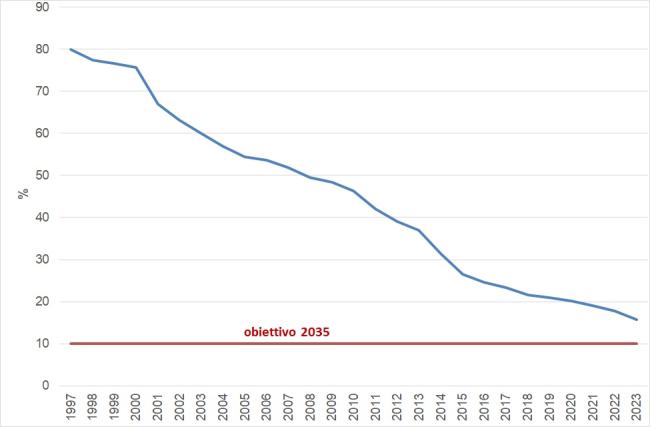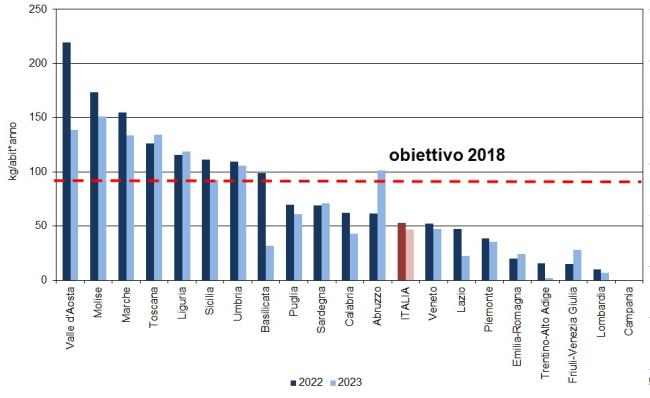Panel 1
Patrizia D'Alessandro
In 2023, the total amount of municipal waste disposed of in landfills amounted to approximately 4.6 million tonnes, with 112 landfill facilities in operation nationwide. Compared to 2022, this represents a 10.8% reduction in the total quantity of municipal waste landfilled (equivalent to -559,000 tonnes) and a 4.3% decrease in the number of operational sites (-5 facilities).
This indicator represents the amount of municipal waste disposed of in landfills and the number of operational landfill sites handling municipal waste.
To monitor the application of the European waste management hierarchy established by Article 4 of Directive 2008/98/EC and subsequent amendments, which considers landfill disposal as a residual form of waste management. Additionally, to verify the progress toward reducing the biodegradable fraction of municipal waste disposed of in landfills.
Directive 1999/31/EC on landfill waste and subsequent amendments.
Decision 2003/33/EC, which sets out criteria and procedures for waste acceptance at landfills under Article 16 and Annex II of Directive 1999/31/EC.
Legislative Decree 36/2003, implementing Directive 1999/31/EC on landfill waste.
Legislative Decree 152/2006, on environmental regulations (Part IV) and subsequent amendments.
Directive 2008/98/EC on waste and subsequent amendments.
Ministerial Decree of September 27, 2010, defining criteria for landfill waste acceptance, amended by Ministerial Decree of June 24, 2015.
Directive 2018/850/EU, amending Directive 1999/31/EC on landfill waste.
Directive 2018/851/EU, amending Directive 2008/98/EC on waste.
Legislative Decree No. 121/2020 (September 3, 2020), implementing Directive 2018/850/EU.
Directive 1999/31/EC sets waste reduction targets for each Member State. From the date of its entry into force:
Within 5 years, the biodegradable municipal waste (BMW) disposed of in landfills must be reduced to 75% (by weight) of the total BMW produced in 1995.
Within 8 years, it must be reduced to 50%.
Within 15 years, it must be reduced to 35%.
This directive was transposed into national legislation through Legislative Decree 36/2003, which establishes operational and technical requirements for landfill sites, defining construction criteria, management procedures, and environmental impact mitigation measures. Under this decree, regions developed programs to reduce the biodegradable fraction of landfill waste, setting short-term (173 kg per capita per year by 2008), medium-term (115 kg per capita per year by 2011), and long-term (81 kg per capita per year by 2018) targets.
Directive 2008/98/EC establishes key waste management principles, prioritizing environmentally preferable waste management options. In this hierarchy, landfill disposal is the least preferred option, intended only as a residual solution.
Criteria for landfill waste acceptance are defined in Legislative Decree 36/2003 and, more specifically, in the Ministerial Decree of September 27, 2010, which transposes Decision 2003/33/EC of the European Commission.
Directive 2018/850/EU, which entered into force on July 4, 2018, amends Directive 1999/31/EC and mandates a progressive reduction in landfill disposal of municipal waste, setting a 10% landfill disposal target by 2035.
Legislative Decree No. 121 of September 3, 2020 (amending Legislative Decree 152/2006), sets new recycling targets to be achieved by 2030 (at least 65%) and a reduction in landfill disposal to no more than 10% of total waste generated by 2035.
Panel 2
ISPRA, Rapporto Rifiuti Urbani - Edition 2023 (Rapporti n. 393/2023, integral version)
https://www.isprambiente.gov.it/it/pubblicazioni/rapporti/rapporto-rifiuti-urbani-edizione-2023
Data quality assessment
ISPRA (Italian National Institute for Environmental Protection and Research)
ISPRA - Catasto rifiuti (http://www.catasto-rifiuti.isprambiente.it)
National (I), Regional (R 20/20)
1997-2023
Indicator assessment
Landfill disposal data were compiled from the 2023 Environmental Declaration Form (MUD) for municipal waste, referring to the year 2022. These data were cross-checked with information collected through questionnaires sent by ISPRA to all relevant authorities responsible for permits and environmental monitoring (Regions, Provinces, Regional and Provincial Environmental Protection Agencies, and Provincial Waste Observatories). The data processing phase often reveals inconsistencies that require further investigation of individual landfill sites.
The biodegradable fraction of landfill waste is estimated by ISPRA based on the composition of mixed waste disposed of in landfills, verified through specific investigative campaigns.
An analysis of landfill disposal relative to total municipal waste generation (approximately 29.3 million tonnes in 2023) shows that 15.7% of municipal waste is still being landfilled at the national level (Figure 1). According to Directive (EU) 2018/850, this percentage must be reduced to 10% by 2035.
Between 2000 and 2023, the quantity of municipal waste disposed of in landfills decreased by 79%, outlining a clear positive trend (Table 1). Specifically, in 2023, there was a 10.8% reduction compared to 2022 in the volume of waste sent to landfill, accompanied by a decrease in the number of operational facilities (-5). Regionally, the number of landfill sites declined from 50 to 49 in the North, from 25 to 24 in the Center, and from 42 to 39 in the South (Table 3).
Data
Table 1: Municipal waste landfilled, by geographical macro-area
ISPRA
Table 2: Amount of municipal waste landfilled at the regional level
ISPRA


In 2023, the total quantity of municipal waste disposed of in landfills amounted to approximately 4.6 million tonnes, representing a reduction of 559,000 tonnes compared to 2022 (Table 1). Of the total landfilled, 28.5% (1.3 million tonnes) was managed in facilities located in Northern Italy, 33% (1.5 million tonnes) in Central Italy, and 38.5% (around 1.8 million tonnes) in Southern Italy (Table 2).
A regional-level analysis shows that the decline from 2022 to 2023 was primarily concentrated in Central and Southern Italy, where reductions of approximately 238,000 tonnes (-13.6%) and 235,000 tonnes (-11.7%) were recorded, respectively. In the North, the decrease was approximately 86,000 tonnes (-6.1%). The significant reduction observed in Central Italy is mainly attributable to the Lazio region, where landfill disposal dropped by 52.5% compared to 2022 (around -236,000 tonnes), alongside a slight increase in separate collection, which rose from 54.5% in 2022 to 55.4% in 2023 (about +30,000 tonnes).
The Marche region also recorded a decrease in landfilled waste (-13.4%), as did Umbria (-3.4%). Tuscany, in contrast, experienced a 7% increase (+approximately 54,000 tonnes).
In Southern Italy, the largest quantitative reduction occurred in Sicily (-149,000 tonnes, -16.8%), where the decrease in landfill disposal appears linked to the rise in separate collection, which increased from 51.5% in 2022 to 55.2% in 2023—equivalent to over 56,000 tonnes. Decreases were also noted in Calabria (-approximately 59,000 tonnes, -30.7%), Apulia (-58,000 tonnes, -12.8%), Basilicata (-45,000 tonnes, -61.6%), and Molise (-11,000 tonnes, -12.8%). In Molise, it is worth noting that about 25,000 tonnes of landfilled waste originated from outside the region.
Conversely, Abruzzo saw a 63.6% increase in landfill disposal (+83,000 tonnes), due to a rise in pre-treated waste quantities (from approximately 130,000 tonnes to 214,000 tonnes). Separate collection in the region remained virtually unchanged, moving from 64.5% in 2022 to 64.6% in 2023. Of the waste sent to landfill in Abruzzo, approximately 57,000 tonnes came from outside the region. Sardinia also reported a slight increase in landfill disposal (+2%, or about 4,000 tonnes).
In Campania, where no operational landfill sites have existed since 2021, municipal waste is not landfilled locally but sent for disposal outside the region.
In the North, reductions were recorded in Lombardy (-31.2%), Veneto (-9.2%), Trentino-Alto Adige (-87.9%), Piedmont (-8.1%), and Aosta Valley (-36.9%). Increases were observed in Emilia-Romagna (+22.5%), which also recorded rises in both municipal waste generation and separate collection, the latter rising from 74% in 2022 to 77.1% in 2023. Increases were also reported in Friuli-Venezia Giulia (+87.1%, or approximately +26,000 tonnes) and Liguria (+2.9%, or approximately +9,000 tonnes).
In 2023, a total of 112 non-hazardous waste landfills were operational nationwide and received municipal waste. Compared to 2022, this represents a decrease of five sites: in the North, from 50 to 49; in the Center, from 25 to 24; and in the South, from 42 to 39 (Table 3).
Legislative Decree No. 36/2003, as amended, establishes progressive targets for reducing the landfilling of biodegradable municipal waste (BMW) at the level of optimal territorial areas: short-term (173 kg/inhabitant/year by 2008), medium-term (115 kg/inhabitant/year by 2011), and long-term (81 kg/inhabitant/year by 2018).
In 2023, the national per capita amount of biodegradable waste sent to landfill was 47 kg/inhabitant, well below the long-term target of 81 kg/inhabitant/year set by Italian legislation for 2018 (Figure 2).
Eleven regions met this 2018 target: Trentino-Alto Adige, Lombardy, Lazio, Emilia-Romagna, Friuli-Venezia Giulia, Piedmont, Calabria, Veneto, Basilicata, Apulia, and Sardinia. Campania is excluded from this assessment, as it has no operational landfill sites.
The regions furthest from achieving the target were Molise (151 kg/inhabitant), Aosta Valley (139 kg/inhabitant), Tuscany (135 kg/inhabitant), and Marche (134 kg/inhabitant). In the latter two regions—as in Molise—values are significantly affected by inflows of waste originating from other regions (Figure 2).